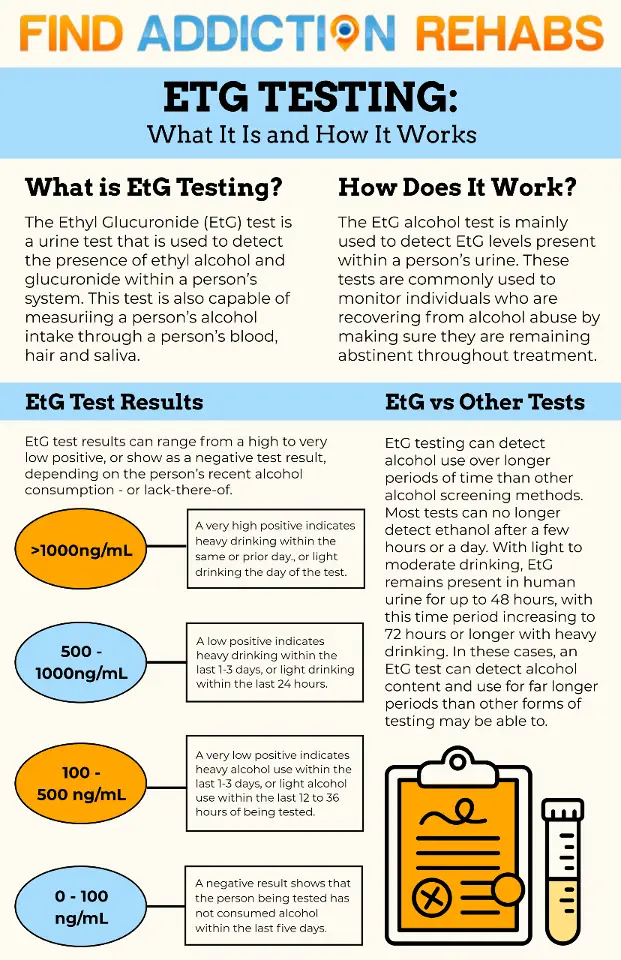What is EtG?
Table of Contents
- What is EtG?
- What is an EtG Test?
- Understanding EtG Test Results
- Can An EtG Test Determine How Much Alcohol Has Been Consumed?
- How Accurate Are EtG Tests?
- Are EtG Tests Better Than Other Alcohol Tests?
- How Much Alcohol Will Cause a Positive EtG Test?
- How Is EtG Testing Used?
- Finding Alcohol Treatment and Recovery Services
- Medically Reviewed By
Ethyl Glucuronide, or EtG, is a byproduct of ethanol and glucuronide. Ethanol is the main chemical compound found in alcoholic beverages.
Meanwhile, glucuronide is a compound that is made in the liver that binds toxins in the body so that they can be filtered out through urine.
What is an EtG Test?
The Ethyl Glucuronide or EtG test is a urine test that is used to detect the presence of ethyl alcohol and glucuronide within a person’s system. In addition to testing urine samples, this test measures a person’s blood alcohol level, as well as the presence of alcohol in hair and nails.
Mainly, however, this form of alcohol testing is mainly used to detect EtG levels present within a person’s urine.
In particular, an EtG test is mainly used for monitoring abstinence for those who are recovering from an alcohol use disorder while receiving substance abuse treatment.
Understanding EtG Test Results
When it comes to the results of an EtG alcohol test, these can range from a high to very low positive or may show as a negative test result, depending on the person’s recent alcohol consumption – or lack of consumption, depending on the circumstances.
High Positive
A high positive EtG test will occur if someone’s EtG levels range around >1,000ng/mL. These Ethyl Glucuronide levels may indicate:
- Heavy drinking that has occurred within the same or previous day.
- Light drinking that has occurred within the same day of the test.
Low Positive
Low positive EtG alcohol test results will range from 500 to 1,000ng/mL, and can determine the possibility of:
- Heavy drinking has occurred within the last one to three days.
- Light drinking has occurred within the last 24 hours.
Of course, low false positives may occur in the event that someone has been recently exposed to environmental products that contain alcohol, particularly within 24 hours of having received an EtG alcohol test.
Very Low Positive
A very low positive result for an EtG alcohol test will range from 100 to 500 ng/mL. These levels will typically indicate:
- Heavy alcohol use that has occurred within the last one to three days.
- Light alcohol use that has occurred within the last 12 to 36 hours.
As with low false positives, a very low false positive test may occur if someone has had somewhat recent exposure to certain environmental products that contain detectable levels of alcohol in them.
Negative EtG Test
A negative EtG test shows that the individual receiving the EtG alcohol screen has not had any ethanol exposure within the testing time frame of up to five days.
It is important to keep track of any potential factors that may cause a false positive when receiving a drug or alcohol screen. This may include, as previously stated, exposure to certain household or environmental alcohol-containing products.
Furthermore, false positives can also occur if someone has a urinary tract infection, although this is only possible if they also have diabetes.
Can An EtG Test Determine How Much Alcohol Has Been Consumed?
Although EtG alcohol testing can detect alcohol consumption within a certain timeframe, these tests will not be able to determine the exact number of standard drinks consumed by the individual.
In other words, it will not be able to detect how much EtG exactly is present in a person’s urine sample (or any other sample being tested).
Generally, the more time has passed since the person last consumed alcohol, the lower their overall EtG levels will be.
There is also the factor that some people will convert more alcohol into EtG than others will, depending on their specific biological make-up, meaning they will also excrete these products faster.
EtG testing also has a maximum measurable amount of these compounds that can be tested, so someone drinking alcohol above this limit will not necessarily have a higher or lower positive than someone else who has been drinking in moderate amounts.
How Accurate Are EtG Tests?
As discussed, there are several limitations that can affect the accuracy of EtG testing. For starters, it is important that these tests be stored properly in order to avoid bacteria growth that may affect the validity of their results.
Furthermore, an EtG test can also produce false positive results in the event that someone has been exposed to external products containing alcohol. These may include:
- Aftershave products
- Breath fresheners
- Cleaning products
- Cosmetic products
- Foods containing alcohol
- Hair dye products
- Hand sanitizer
- Hygienic products
- Mouthwash
Although there are several products that may produce EtG levels high enough to be detected by an EtG test, these screening tools can determine if a person has chosen to consume alcohol more accurately than most other tests.
Are EtG Tests Better Than Other Alcohol Tests?
An EtG urine test can detect alcohol use over longer periods of time than a blood alcohol test or a breathalyzer test, which calculates the amount of consumed alcohol using a person’s breath.
Most tests can no longer detect alcohol after a few hours or a day. With moderate drinking, EtG remains present in human urine for up to 48 hours, with this time period increasing to 72 hours or longer with heavy drinking.
In these cases, an EtG test can detect alcohol content and usage for far longer periods than another testing may be able to.
How Much Alcohol Will Cause a Positive EtG Test?
Even after just one drink, an EtG test can detect this consumption once alcohol enters the person’s system. If the person chooses to stop drinking, an EtG drug test will still be able to detect the alcohol even into the next day.
This is why these are commonly used for those recovering from alcohol use disorders, as they can help ensure these individuals are staying on track with their recovery and maintaining abstinence.
How Is EtG Testing Used?
The EtG test, as discussed, is most commonly used within alcohol addiction treatment in order to ensure that recovering individuals are not drinking.
There are many recovery programs that may utilize EtG testing to ensure alcohol abstinence, including:
- Alcohol addiction treatment programs
- Court cases
- DUI or DWI programs
- Liver transplant cases
- Probation programs
- Professional career monitoring programs
- Certain academic institutions or the military
Whether an EtG test is being used within a substance abuse treatment program or as a way of monitoring a person’s eligibility for certain academic, work, or home-related pursuits, these tests can help keep individuals on track with their sobriety and personal goals.
Finding Alcohol Treatment and Recovery Services
If you believe that you or a loved one may be struggling with an alcohol use disorder, this can be an incredibly difficult thing to deal with. However, it is important to know that you are not alone, and help IS available.
At Find Addiction Rehabs, we help people like you find an addiction treatment center and recovery programs that are dedicated to serving all of your personal care needs. Our hotline is available 24/7 to provide you with recovery resources and tools anytime you need them.
So don’t wait; call now, and we can help you start your recovery journey by connecting you with sober support programs and alcohol addiction treatment specialists, today!
Deborah Tayloe is a freelance writer specializing in health and sciences. Deborah earned a B.S.Ed. in Secondary Education/English, accompanied by a Spanish minor. Her writing expertise allows her to craft engaging, impactful articles to help people be well.
In addition, she holds a fully accredited Certificate of Natural Medicine and is a certified Herbalist. Through her understanding of complementary medicine, Deborah helps medical professionals give people the information they need to embrace natural approaches to wellness.
When she’s not working, Deborah trains for 5K races and advocates for animal rights.




